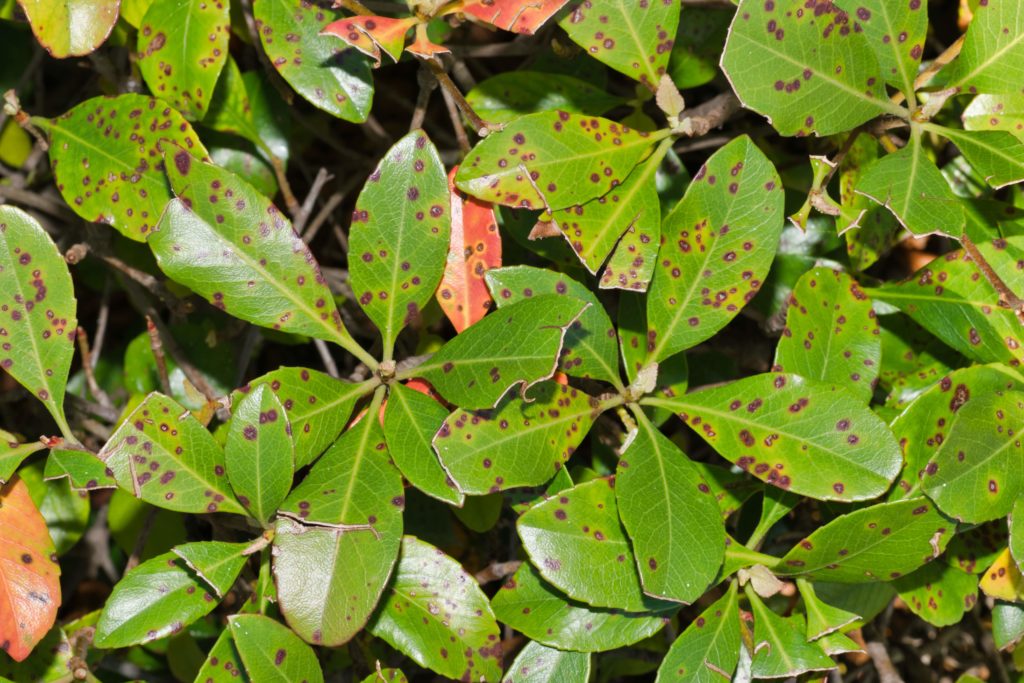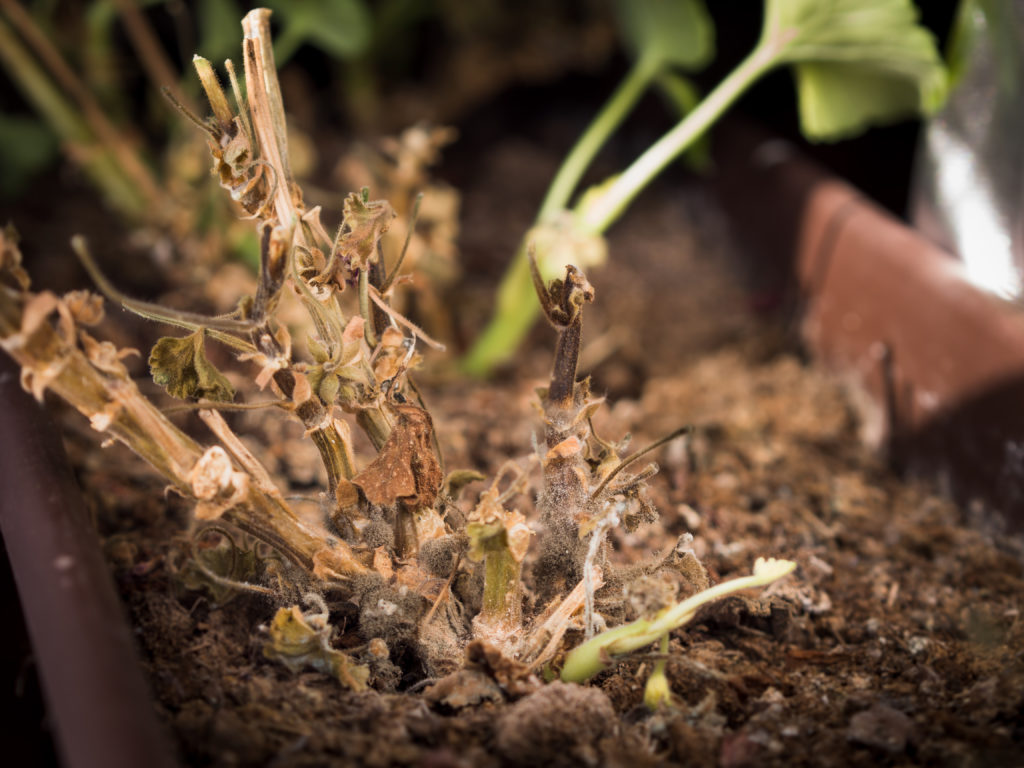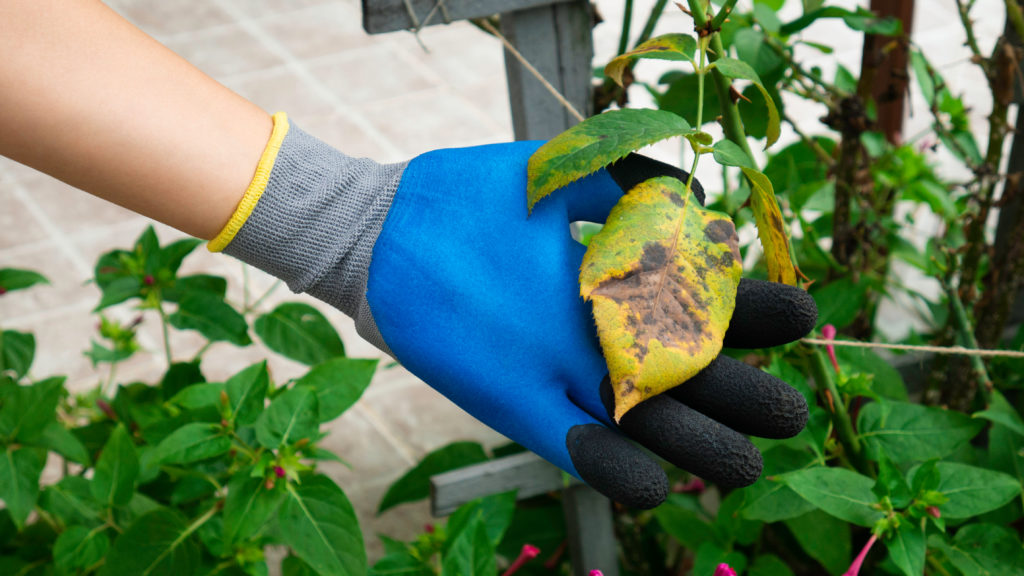Box blight is the worst nightmare for any proud box plant owner. Causing noticeable dead leaves and stem dieback, box blight is likely to lead to the death of box plants if left untreated. Although this disease is relatively new, only appearing in the UK in 1994[1], there are several ways we know that can help you treat it. To answer all your questions, from what does box blight look like to how you can prevent it, this is our guide to treating box blight in the garden.
What Is Box Blight?

Box blight is a disease of the leaves and stems of buxus, or box, plants. The disease is usually caused by two related fungi called Calonectria pseudonaviculata and Calonectria henricotiae, though other species may be involved with the disease’s development since box plants can suffer from various issues. These species of fungi differ in their susceptibility to fungicides[2]. Typically, a species called cylindrocladium buxicola is the most damaging. On the other hand, volutella buxi is less aggressive[3]. There are around 104 accepted species of box plants[4], all of which are susceptible to box blight. However, the disease most commonly affects buxus spp. Usually, box blight is not fatal, though it does require some effort to manage.
What Does Box Blight Look Like?

It’s important to diagnose box blight correctly, since managing the disease can be difficult. Try and determine if your plants are suffering from box blight as early as possible, since the further advanced the infestation, the harder it will be to deal with. Look out for the following symptoms:
- Dark brown spots or lesions on the leaves – The first sign of box blight is usually dark spots appearing on the leaves. Depending on the species of box blight your plants have been infected with, the colouring of this symptom may be pink, grey, or bronze[5].
- Defoliation – Not long after dark spots appear, the leaves will turn completely brown and eventually fall off. If defoliation doesn’t kill the plants immediately, the process will repeat and eventually kill the plant.
- Dieback On Stems – As box blight spreads, the stems of the infected plants will begin to develop black or brown lesions, particularly young stems. This will lead to the stems beginning to dieback.
- White Spore Masses on Affected Leaves – During wet conditions, you may see the white spores of the fungus may be visible on the underside of infected leaves. If your plants are infected with volutella blight, these spore masses will look pink[6].
Box blight will not affect the roots of your plants, meaning they may continue to try and put out fresh leaves. Don’t let this fool you, as box blight will kill your plants if it remains untreated.
How Does Box Blight Spread?

The fungi present in box blight can spread in numerous ways, which is why box blight is such a rapidly spreading disease. Usually, the fungus can reproduce in infected stems and leaves, including the dead stems and fallen leaves. The fungal spores that have developed within the infected tissues become vehicles of the disease that allow it to spread to healthy plants. Also, box blight can be spread by wind, water and passing wildlife. Infection spreads quickly, particularly in warm and humid conditions, so it is likely to have progressed further than you can see. Because of this, you should be wary before introducing new, healthy plants to an area of established boxwood, since the symptoms of box blight may have been masked but not killed[7].
Box Blight Treatment

As mentioned above, box blight is particularly difficult to manage. So, it’s best to combine treatment strategies to ensure you squash the disease for good. However, your treatments must be coordinated and practical for your garden. Pay particular attention to removing the sources of infection and protecting regular growth, however this may work for you and your garden. Some of the best options for successfully treating box blight are:
Make Your Garden More Hygienic
Practising good hygiene in the garden will help prevent and deal with a range of outdoor issues. These treatment tips aim to deal with box blight, but keeping them in practice once the infection is dealt with will keep your garden healthy.
- Use gloves to bag up any infected material and dispose of safely in your garden waste bin. Avoid dropping any debris on the garden, and don’t add the materials to your compost bin as this will further spread the infection.
- Thoroughly clean pruning tools with a garden disinfectant before and after use on infected plants. Also wash your gardening clothes after working in any infected areas.
- Clean any soil and leaves off the soles of your shoes to remove any stuck spores.
- Consider using a fungicide before cutting back infected plants. This may reduce the risk of developing spores spreading during and after cutting. However, make sure to only use chemical solutions in minimal amounts.
- Make sure to quarantine any new plants if you plan on replacing them with more box species[8].
Cut Back The Affected Areas
Removing as much of the infected areas as you can will improve the chances of healthy recovery in your plants. Depending on how far your infestation has spread, there are several options for cutting back your affected plants. Here’s what you should do depending on the severity of your situation:
- If You’ve Detected An Infection Early Or You Plan To Apply Fungicides: Cut out all the visible infected areas that you can see. Then, cut out a little more, since some infections may not be visible yet. Apply your fungicide before cutting and then once more after two weeks.
- If The Infection Has Spread Over Large Areas or Your Hedges: Remove all black spots from the stems by cutting them back. You may have to reduce the width and height of your shrubs, but this is essential to cutting off the disease. Reduction may be less severe if you apply a fungicide.
- If Your Infection Is Severe but You Wish To Save A Box Feature, or If You Don’t Want To Apply Fungicides: Cut back any plants that are showing box blight symptoms to ground level, until they are just stumps. It’s best not to do this in wet conditions, as infectious spores may spread.
- If Your Infection Is Very Severe or It Threatens Other Box Plants: Completely remove the affected plants. Make sure they are properly disposed of and do not come in contact with other plants. Furthermore, avoid planting in that place in future. Box blight spores can live for up to six years[9], and will easily infect new plantings[10].
Remove Infested Leaves and Soil
Box blight spores travel quickly and often invisibly, so removing potentially infested leaves and soil may help stave off the spread. First, lay down a tarpaulin or other covering that will catch your clippings and debris easily without spreading the infection. Use clean pruning shears to remove dislodged or visibly infected leaves, and clean up all fallen leaves from around the plants. Finally, remove the top layer of soil beneath the plants to get rid of infected fragments, then top it off with a fresh layer of soil.
Encourage A Healthy Recovery
Once the infection is being contained, you can shift your focus to promoting the recovery of your garden. Things that may help infected areas recover include:
- Creating an open environment, avoiding overhanging or crowding plants
- Changing the design of your garden. For example, un-susceptible plants will be better in high risk areas
- Regularly apply a mulch to encourage healthy growth and cover any infected leaves
- Clip box plants in dry weather
- Apply a fertiliser during summer or spring to reduce the chances of your plants losing leaves
- Don’t apply too much nitrogen as this can provide the ideal climate for box blight to develop
Look Out For New Infections
Since box blight is so difficult to control, it’s unlikely that you’ll wipe the whole infection out in your first attempt. So, you should monitor your plants and detect any new infections early. Box blight can reoccur at any time of the year, so remain vigilant and take steps to remove the infection as soon as possible.
Focus on previously infected areas, but don’t neglect the rest of your garden in case the infection has spread. Inspect any changes, such as yellow patches, even if they don’t look like common box blight. It’s best to rule it out early.
How To Prevent Box Blight

There are several things you can do to help prevent box blight, whether your garden is recovering from an infestation or you’re worried about your new plants. To prevent box blight, you should:
- Clean tools, equipment, and gardening tools regularly
- Don’t reuse these tools on other areas of your garden
- Prune your box plants once a year during dry weather
- Allow healthy air circulation around your plants
- Avoid overhead watering
- Apply mulch to avoid water splashing
- Apply an organic plant tonic
- Don’t replant for at least six years after the infection
- Grow resistant varieties[11]
Managing Your Box Blight
Just because box blight is difficult to manage, it doesn’t mean it’s impossible. Although it is likely to be a long process, your effort and labour will pay off eventually if you stick with your treatment. Good luck!
Have you got any box blight treatment tips that might help? Let us know in the comments!
Here at Sefton Meadows, we specialise in top quality garden furniture to allow you to enjoy your garden in complete luxury. Check out our varied range to prepare your garden for the sweltering summer, or even get ahead on Christmas!
Sources
[1] https://www.rhs.org.uk/science/pdf/plant-health/box-blight-rampages-onwards.pdf
[2] https://www.rhs.org.uk/disease/box-blight
[3] https://gardening.which.co.uk/hc/en-gb/articles/214051205-Box-blight
[4] http://www.theplantlist.org/1.1/browse/A/Buxaceae/Buxus/
[5] https://www.hopesgrovenurseries.co.uk/knowledge-base/dealing-with-box-blight/
[6] https://www.bettyongardening.com/gardening-articles/boxwood-blight-how-to-recognize-it-and-what-to-do-about-it/
[7] https://gardening.which.co.uk/hc/en-gb/articles/214051205-Box-blight
[8] https://www.rhs.org.uk/prevention-protection/box-blight-managing-outbreaks
[9] https://www.hopesgrovenurseries.co.uk/knowledge-base/dealing-with-box-blight/
[10] https://www.gardenersworld.com/how-to/grow-plants/box-blight/
[11] https://www.newgenboxwood.com/boxwood-blight-1
Ryan Jenkins is a professional gardener and has been working in the gardening industry for over 25 years. This has allowed Ryan to accumulate a vast wealth of gardening knowledge which he shares on the Sefton Meadows blog.




